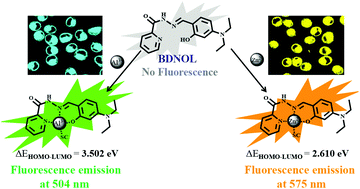A simple Schiff base as dual-responsive fluorescent sensor for bioimaging recognition of Zn2+ and Al3+ in living cells†
Abstract
A simple Schiff base fluorescent sensor (BDNOL) was synthesized from the reaction of picolinohydrazide and 4-(diethylamino)salicylaldehyde, and developed for selective detection of Al3+ and Zn2+. This non-fluorescent sensor displayed obvious fluorescence enhancement after binding to Al3+/Zn2+ ions with high sensitivity and selectivity, accompanied by obvious fluorescence emission enhancement (504 nm for Al3+ and 575 nm for Zn2+). The detection limits were found to be 8.30 × 10−8 M for Al3+ and 1.24 × 10−7 M for Zn2+. The binding mechanisms between BDNOL and Al3+/Zn2+ ions were supported by 1H NMR and HR-MS analysis, and a density functional theory (DFT) study. The sensing behavior was also studied with molecular logic functions of OR, AND, and NOT gates. Furthermore, the fluorescent sensor was successfully used to recognize Al3+ and Zn2+ in living cells, suggesting that this simple biosensor has great potential in biological imaging applications.



 Please wait while we load your content...
Please wait while we load your content...